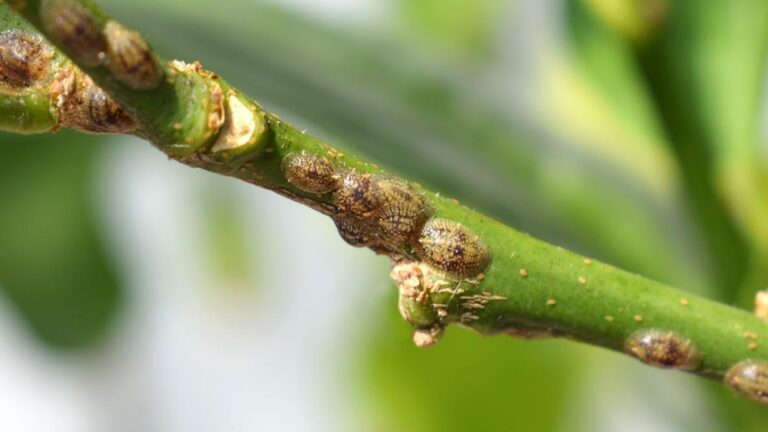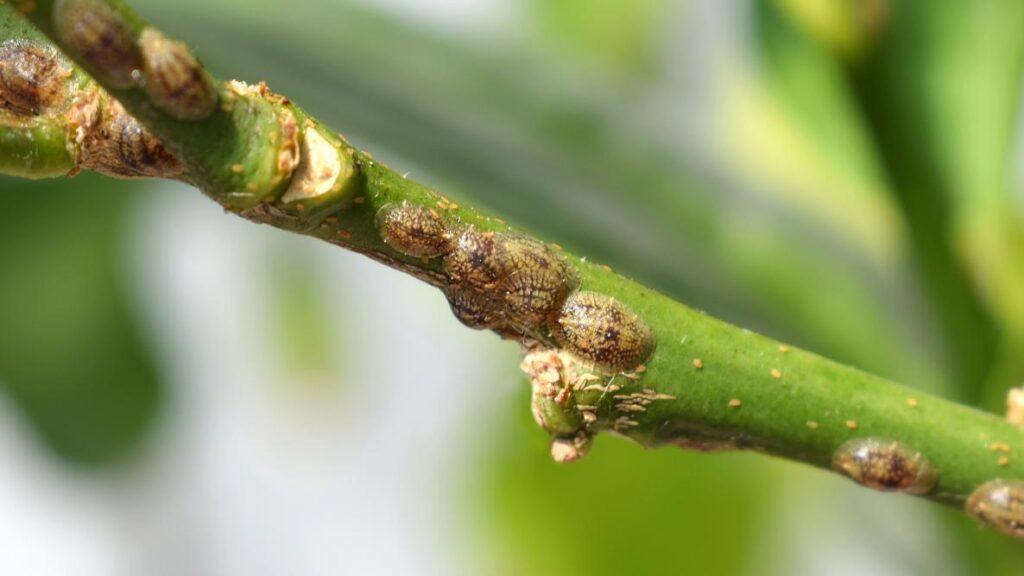Table of Contents
What Are Scale Insects?
Scale insects are a type of plant pest belonging to the order Hemiptera, which also includes aphids and cicadas. They are named after the scale-like appearance of their protective covering. These insects feed on the sap of plants by piercing the plant tissue with their mouthparts.
Scale insects can be categorized into two main types: soft scale and hard scale. Soft scale insects secrete a waxy substance that covers their bodies, while hard scale insects have a hard, shell-like covering.
These pests can be detrimental to plants because they can weaken them by sucking out their sap, causing stunted growth, yellowing leaves, and even death in severe cases. Additionally, some species of scale insects excrete a sugary substance called honeydew, which can attract ants and promote the growth of sooty mold.
Controlling scale insects often requires a combination of cultural, mechanical, and chemical methods. These may include pruning heavily infested branches, physically removing the insects with a brush or cloth, introducing natural predators like ladybugs or parasitic wasps, and using insecticidal soaps or oils to kill the pests.
5 Types of Scale Insects
Scale insects encompass a diverse group with numerous species, each with its own characteristics and behaviors. Here are some common types of scale insects found on plants:
Soft Scale Insects: These insects have a soft, waxy covering over their bodies. They are relatively larger compared to hard scale insects. Examples include:
- Cottony cushion scale (Icerya purchasi)
- Brown soft scale (Coccus hesperidum)
- Black scale (Saissetia oleae)
Hard Scale Insects: Hard scale insects have a hard, shell-like covering made of waxy secretions. They often attach firmly to plant surfaces. Examples include:
- San Jose scale (Quadraspidiotus perniciosus)
- Florida red scale (Chrysomphalus aonidum)
- Oleander scale (Aspidiotus nerii)
Armored Scale Insects: Armored scale insects are a subgroup of scale insects characterized by a tough, armored covering. They are generally small and can be challenging to control. Examples include:
- European fruit lecanium (Parthenolecanium corni)
- Oystershell scale (Lepidosaphes ulmi)
- California red scale (Aonidiella aurantii)
Mealybugs: Mealybugs are closely related to scale insects and share some similarities in appearance. They have a powdery or mealy wax covering over their bodies. While not technically scales, they are often grouped together due to their similar feeding habits and management strategies. Examples include:
- Citrus mealybug (Planococcus citri)
- Longtailed mealybug (Pseudococcus longispinus)
- Grape mealybug (Pseudococcus maritimus)
These are just a few examples of the many types of scale insects that can infest plants. Each species may have specific host plants, life cycles, and management challenges. Identifying the specific type of scale insect infestation is crucial for implementing effective control measures.
How to Get Rid of Scale Insects
Getting rid of scale insects on plants typically involves a combination of cultural, mechanical, and chemical control methods. Here’s a step-by-step approach:
Inspect Your Plants: Regularly inspect your plants for signs of scale infestation. Look for small, oval-shaped insects attached to stems, leaves, or the undersides of leaves. Also, watch for the presence of honeydew or sooty mold, which indicates scale insect activity.
Prune Infested Branches: If the infestation is localized, prune and discard heavily infested branches or plant parts. This helps remove a significant portion of the scale population and prevents the spread of the infestation.
Mechanical Control: Use a soft brush or cloth dipped in soapy water to physically remove scale insects from the plant surfaces. Gently scrub the affected areas to dislodge the insects and their protective coverings.
Natural Predators: Introduce natural predators such as ladybugs, lacewings, parasitic wasps, or predatory beetles to help control the scale insect population. These beneficial insects can feed on scale insects and their eggs, reducing their numbers over time.
Horticultural Oil Sprays: Apply horticultural oil sprays during the dormant season or when scale insects are in the crawler stage (young, mobile nymphs). These oils suffocate the insects by coating their bodies and blocking their breathing pores. Follow the manufacturer’s instructions carefully when applying oils to avoid damaging the plants.
Insecticidal Soaps: Insecticidal soaps can be effective against scale insects, especially when applied directly to the pests. These soaps disrupt the insect’s cell membranes, leading to dehydration and death. Thorough coverage of the affected plant parts is essential for effective control.
Systemic Insecticides: In severe infestations, systemic insecticides may be necessary. These insecticides are absorbed by the plant and transported throughout its tissues, making them toxic to feeding scale insects. However, use systemic insecticides with caution, following label instructions and considering their potential impact on beneficial insects and the environment.
Monitor and Repeat: Monitor your plants regularly after treatment to ensure that the scale insect population is under control. Repeat treatments as necessary to manage any remaining insects or newly hatched nymphs.
Remember to always follow integrated pest management (IPM) practices, which emphasize the use of multiple control methods and minimal environmental impact. Additionally, proper plant care, including adequate watering, fertilization, and pruning, can help maintain plant health and resilience against scale insect infestations.

6 Harmful Effects of Scale Insects on Plants
Scale insects can cause various harmful effects on plants, ranging from aesthetic damage to severe decline and even death. Here are some of the primary negative impacts of scale insect infestations on plants:
Sap Feeding: Scale insects feed on the sap of plants by piercing their phloem or xylem tissues with their specialized mouthparts. This feeding activity can lead to reduced vigor and growth in infested plants, as they are deprived of essential nutrients and water.
Stunted Growth: Heavy infestations of scale insects can stunt the growth of plants, particularly young shoots and leaves. The constant draining of sap weakens the plant’s ability to produce new growth, resulting in stunted or distorted foliage.
Yellowing and Wilting: Plants infested with scale insects may exhibit symptoms of stress, such as yellowing or wilting leaves. The loss of sap and nutrients can disrupt the plant’s normal physiological processes, leading to leaf discoloration, drooping, and eventual leaf drop.
Dieback: Severe infestations of scale insects can cause dieback of branches or entire plants. As the insects drain the plant’s resources and weaken its defense mechanisms, affected parts may wither, turn brown, and eventually die off. This can result in significant aesthetic and structural damage to the plant.
Honeydew and Sooty Mold: Some species of scale insects excrete a sugary substance called honeydew as they feed on plant sap. Honeydew can accumulate on plant surfaces, attracting ants and promoting the growth of sooty mold fungi. Sooty mold forms a black, powdery coating on leaves, inhibiting photosynthesis and further weakening the plant.
Secondary Damage: Scale insects can weaken plants and make them more susceptible to secondary pests, diseases, and environmental stresses. Infested plants may become more vulnerable to attacks by other insects, fungal pathogens, or adverse growing conditions, exacerbating their decline.
Reduced Yield: Scale infestations can reduce the yield and quality of crops in agricultural settings. Infested fruit trees, ornamental plants, and crops may produce fewer flowers, fruits, or seeds, leading to economic losses for growers and farmers.
Overall, scale insects pose a significant threat to the health and vitality of plants, particularly in agricultural, horticultural, and landscape settings. Prompt identification and management of scale infestations are essential to minimize damage and preserve plant health.
FAQs
What are scale insects?
Scale insects are small, sap-feeding insects that belong to the order Hemiptera. They are named for their scale-like appearance due to the protective covering that many species develop.How do scale insects damage plants?
Scale insects feed on the sap of plants by piercing their tissues with specialized mouthparts. This feeding activity can weaken plants, leading to stunted growth, yellowing leaves, dieback of branches, and, in severe cases, plant death. Additionally, some scale species excrete honeydew, which attracts ants and promotes the growth of sooty mold.How do I identify scale insects on my plants?
Scale insects can vary in appearance depending on the species and life stage. Look for small, oval-shaped insects attached to plant stems, leaves, or the undersides of leaves. They may appear as bumps, scales, or shells, ranging in color from white or yellow to brown or black.How can I control scale insects on my plants?
Control methods for scale insects include cultural practices (such as pruning and sanitation), mechanical control (physically removing insects), biological control (introducing natural predators), and chemical control (using insecticidal soaps or oils, or systemic insecticides). Integrated pest management (IPM) strategies that combine multiple control methods are often the most effective.Are scale insects harmful to humans or pets?
Scale insects primarily feed on plants and are not directly harmful to humans or pets. However, the honeydew excreted by some scale species can attract ants and may be a nuisance. Additionally, certain scale species may secrete irritating substances when disturbed.Can scale insects spread from plant to plant?
Yes, scale insects can spread from plant to plant, particularly through the movement of infested plant material or by crawlers (young nymphs) that can disperse to nearby plants. Care should be taken to isolate or treat infested plants to prevent the spread of scale insects to healthy plants.How can I prevent scale insect infestations?
To prevent scale insect infestations, maintain plant health through proper watering, fertilization, and pruning practices. Regularly inspect plants for signs of infestation, and promptly address any issues to prevent scale populations from becoming established. Quarantine new plants before introducing them to your garden or landscape to avoid introducing scale insects.
Share this post:




